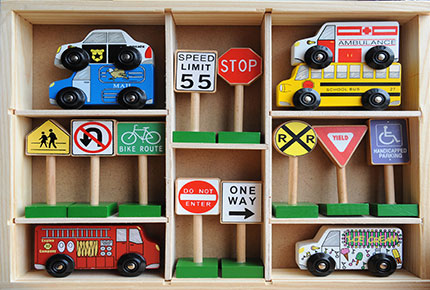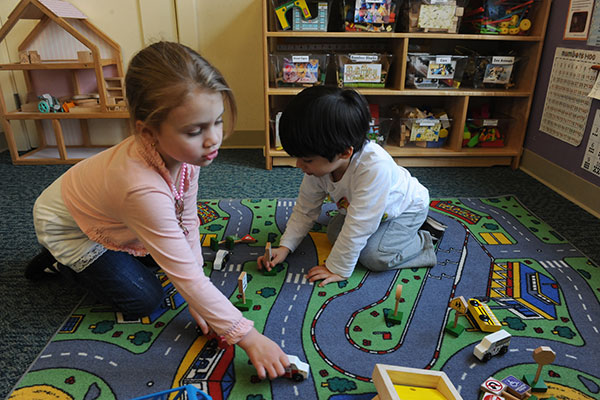2010 TIMPANI Toy Study
(This video has captions. You can turn them on by clicking the CC icon at the bottom of the video.)
Download a printable transcript.
Narrator: The Center for Early Childhood Education at Eastern Connecticut State University is pleased to announce the results of its 2010 TIMPANI Toy Study: Toys that inspire mindful play and nurture imagination. We know that young children learn critical skills and knowledge through their play. When children create a make-believe world, race a friend to the top of a hill, or build a tower of blocks, they acquire the social and intellectual abilities needed for success in school and adulthood. While there is much research on children’s play, few studies have looked at how children interact with toys in their play. To address this research gap, the Center recently completed the TIMPANI Toy Study under the direction of Dr. Jeffrey Trawick-Smith. The study looked at how young children in natural settings played with a variety of toys.
METHODOLOGY
Dr. Jeffrey Trawick-Smith, Principal Investigator: Our primary research question was do individual toys make a difference in terms of children’s play and their learning. One of the things that we did was, for this study is to develop a scientific instrument to study the effects of toys. We boiled this down into three broad areas. The first area had to do with thinking, learning, and problem solving. As we looked at toys we wanted to see what kind of impact they would have on children’s acquisition of new concepts, whether they studied and explored them intensely for extended periods, and also whether they solved problems with them.
Child: This is the wrong one.
Dr. Trawick-Smith: A second area was social interaction. We looked to see whether toys would facilitate collaboration, you know could children play with them together and did it inspire friendly interaction, although you know that could include conflict as well, whether children talked to each other, whether there was language that was used during their play. And then the third component focused on creativity and imagination, if some toys would lead to greater imaginative behavior, pretend creative expression. We weren’t looking at the exact characteristics of the toy per say but the kind of behavior that each of them would elicit as children play with them.
RESULTS
Narrator: The study provided an opportunity for four Eastern students to engage in meaningful research, helping to meet the university’s mission to provide experiential learning opportunities for students.
Liza Welling, Student Researcher: My professor asked me if I would want to join him over the summer and do a study with him. I thought it would be really interesting because I’ve never done research in Education before. I went through each video and watched a specific child in each video, and then went through the rubric. The rubric told us how much children enjoyed each toy and if they interact enough and how long and if there was conflict with the toy with other students. Seeing them on a video after the fact was really interesting because you could rewind and watch it over, and I got to learn about each student more individually than I think I would have if I was actually in the classroom just watching them first hand play with the toy.
2010 STUDY FINDINGS
Narrator: Over 30 toys were nominated for the 2010 TIMPANI To Study. The toy that earned the highest rating was Wooden Vehicles and Traffic Signs by Melissa and Doug.
Dr. Trawick-Smith: It out-scored some pretty wonderful toys. The colorful, well-designed, wooden toys kind of kept children interested. There were multiple toys that come in this set so it lent itself to collaboration. One of the really high scores on this toy was in relation to children talking with each other and collaborating. There were vehicles for everyone and it kind of lent itself to interaction. The road signs kind of cause children to do things that maybe they wouldn’t do with just wooden, a dump truck. They, for example, they would collaborate in setting up little roads. Well that would lead to fairly high scores on a creativity or imagination scale, but they also involve children in some deep thought. One of the things we saw was children trying to interpret what the road signs said, what they were for.
Ashlee Marouski, Preschool Teacher: I think it sustained their attention; there were some children who sat there for 20 minutes playing with the cars and the signs. I saw them do things with that toy that I wasn’t expecting them to do with it. setting up scenarios , or story lines, the wheels fell off the car, and now the dump truck’s coming to pick the car up, and it was really neat to see them really use their imagination with the toy, more so than, to be honest, than I expected them to do. It also provided them to work cooperatively and collaborate with each other. Two children in particular just kept crashing their cars over and over again, and then an ambulance would come or a fire truck would come, so they kind of created these little scenarios. One interesting thing that I saw that really surprised me was the use of the actual storage that the cars and signs were kept in. One child had stood the storage box up and used it as a garage, and was placing the cars in the garage. Another child, she was balancing the fire truck on, the clear top, which was really interesting because she was kind of shaking it and moving it and seeing if it would fall or she would toss it off of it. One child, when we had it on our circular rug, it’s kind of a meshy rug, and she was pressing hard into the rug, and it was almost as if at first she did it by accident and happened to notice that it left a mark, and so then she started to kind of go horizontally, and then she went vertically. She was going back and forth making these imprints of the tire marks into the rug and kind of making patterns with it. She really stuck with it, and noticed like, oh, well, what did I just make; and how did I do that; and how can I manipulate it and change it? Sometimes its things that are simple that children can really manipulate and do so much with.
Liza Welling: It was very interesting to see that such a simple toy made such a big difference in the classroom, and that students were so engaged with it and played with it for hours, and loved it, and created so many different things with it. As a teacher, you don’t have to include all these high end toys that everyone’s saying are amazing, it comes back down to all the simple things. And letting students use their imagination and create their own world is actually more important.
Narrator: The Center for Early Childhood Education plans to conduct the TIMPANI toy study on an annual basis. For more information or to nominate a toy for future studies, visit our website at www.easternct.edu/cece.




